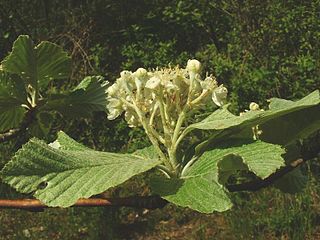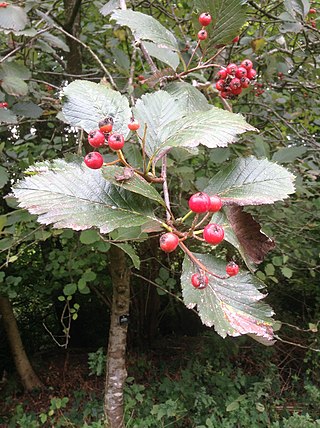
The MaloideaeC.Weber was the apple subfamily, a grouping used by some taxonomists within the rose family, Rosaceae. Recent molecular phylogenetic evidence has shown that the traditional Spiraeoideae and Amygdaloideae form part of the same clade as the traditional Maloideae, and the correct name for this group is Amygdaloideae. Earlier circumscriptions of Maloideae are more-or-less equivalent to subtribe Malinae or to tribe Maleae. The group includes a number of plants bearing commercially important fruits, such as apples and pears, while others are cultivated as ornamentals.

Sorbus is a genus of over 100 species of trees and shrubs in the rose family, Rosaceae. Species of Sorbus (s.str.) are commonly known as rowan or mountain-ash. Currently, species commonly known as whitebeam, chequer tree and service tree are classified in other genera, so that genus Sorbus includes only the pinnate leaved species of former subgenus Sorbus.

The whitebeams are members of the family Rosaceae, comprising a number of deciduous simple or lobe-leaved species formerly lumped together within Sorbus s.l. Many whitebeams are the result of extensive intergeneric hybridisation involving the genera Sorbus, Aria, Torminalis and Chamaemespilus. As an effect, they are commonly apomicts and many have very restricted ranges. The best known species is the common whitebeam, a columnar tree which grows to 25 m (82 ft) tall by 10 m (33 ft) broad, with clusters of white flowers in spring followed by speckled red berries in autumn (fall).

Chamaemespilus is a genus of shrubs in the family Rosaceae. It is monotypic, being represented by the single species Chamaemespilus alpina, commonly known as false medlar or dwarf whitebeam. It is native to the mountains of central and southern Europe, from the Pyrenees east through the Alps to the Carpathians and the Balkans, growing at elevations of up to 2500 m.

Karpatiosorbus latifolia is a species of whitebeam that is endemic to the area around Fontainebleau, south of Paris in France, where it has been known since the early eighteenth century.

Hedlundia anglica, the English whitebeam, is a species of whitebeam tree in the family Rosaceae. It is endemic to Ireland and the United Kingdom, with an entire British population estimated at 600 individuals.
Aria vexans, commonly known as bloody whitebeam, is a rare species of tree in the family Rosaceae. It is endemic to England and is found along the coast between Culbone in Somerset and an area just west of Trentishoe in Devon. It can be seen in the Exmoor National Park. It is threatened by habitat loss.
Aria wilmottiana, commonly known as Willmott's whitebeam, is a species of whitebeam in the family Rosaceae. It is endemic to England, and is found in the Avon Gorge, in Somerset and Gloucestershire. It is threatened by habitat loss.

Hedlundia hybrida, the Swedish service-tree, Finnish whitebeam, or oakleaf mountain ash, is a species of whitebeam native to Norway, eastern Sweden, south-western Finland, and locally in Latvia.

Karpatiosorbus admonitor, previously classified as Sorbus admonitor and also called the Watersmeet whitebeam, is a species of whitebeam tree found in Devon, United Kingdom. It is known only from the Watersmeet Valley at Lynton, with two stray plants growing on the coast above Sillery Sands, Countisbury. It has also been nicknamed the "no parking whitebeam" in some newspapers.

Malinae is the name for the apple subtribe in the rose family, Rosaceae. This name is required by the International Code of Nomenclature for algae, fungi, and plants, which came into force in 2011 for any group at the subtribe rank that includes the genus Malus but not either of the genera Rosa or Amygdalus. The group includes a number of plants bearing commercially important fruits, such as apples and pears, while others are cultivated as ornamentals.

Torminalis is a genus of plants in the rose family, Rosaceae. The genus was formerly included within the genus Sorbus as the section Torminaria, but the simple-leafed species traditionally classified in Sorbus are now considered to form a separate monophyletic group. It is monotypic, being represented by the single species Torminalis glaberrima, commonly known as wild service tree, chequers, and checker tree. This tree is native to Europe, parts of northern Africa and western Asia.
Aria leighensis, commonly known as Leigh Woods whitebeam, is a rare species of whitebeam, a flowering plant in the|rose family Rosaceae.

Karpatiosorbus is a genus of flowering plants in the family Rosaceae, native to Europe, including Crimea, and Algeria. Shrubs or small trees, they appear to have arisen via hybridization events between the clades Aria(Pers.) Host and TorminalisMedik. Many of its species propagate solely by apomixis.

Hedlundia is a genus of plants in the rose family. They are shrubs or small trees that have a hybrid origin involving crosses between Aria and Sorbus sensu stricto. There are about 48 species are distributed across central, western and southern Europe, Scandinavia, Turkey, the Caucasus, Crimea, and also central Asia. The term Hedlundia was published in 2017.
Normeyera is a genus of flowering plants in the rose family, Rosaceae. It includes nine species native to west-central Europe, ranging from France through Switzerland, Germany, Austria, and Czechoslovakia to Poland.

Scandosorbus is a genus of flowering plants in the rose family, Rosaceae. It includes two species of trees native to northern Europe.












